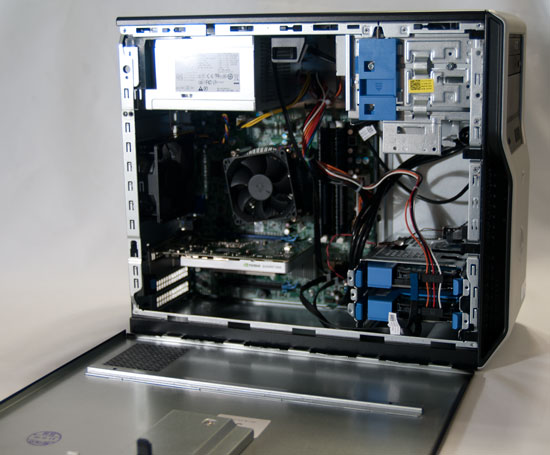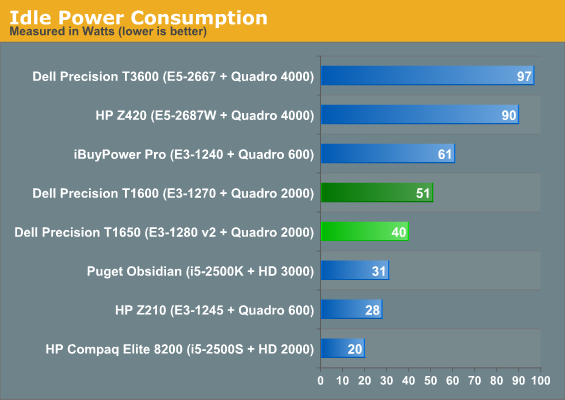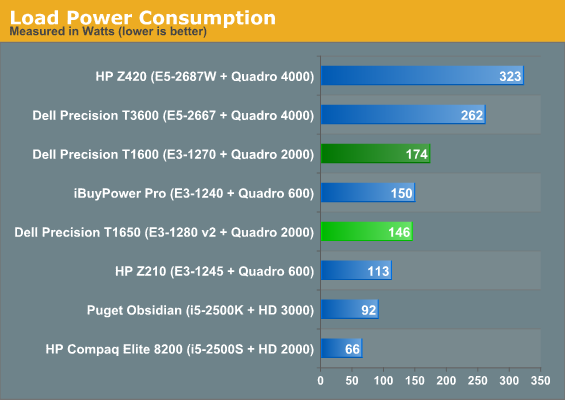Dell Precision T1650 Workstation Review: Ivy Bridge Xeons Bring Performance
by Dustin Sklavos on July 31, 2012 12:00 AM EST- Posted in
- Systems
- Dell
- Workstation
- Ivy Bridge
- Enterprise
Build Quality
Where I do think the Dell Precision T1650 betrays its entry level roots is in the build quality. It's hard not to be disappointed with the T1650 when the T3600 and its brethren have such a vastly superior design. In fact, this is where it's clear just how incremental the T1650's build really is.
.jpg)
So above, we have the interior of the T1650 with everything in its very standard ATX position. This isn't a bad design, necessarily, but I chastised HP for recycling the previous year's chassis with the Z420 and now it's Dell's turn. The front fascia may be different for the T1650, but...

The picture above is the last generation T1600. What's changed? They moved the I/O cluster and swapped out the fascia. That's all. That's it. Compared to the brilliant design decisions and language of the T3600 (seen below)...
.jpg)
...it's very hard not to be disappointed. This isn't a design that can't be shrunk down to suit the T1650, but hitting a price point seems to have been more important. As a result, you lose the smarter airflow and easily replaceable power supply. Worse, you're still stuck paying $50 for an upgrade to an 80 Plus Gold power supply, something that comes standard in the bigger models. HP ships their competing Z220 desktop with 80 Plus Gold power supplies standard.
This isn't a bad internal design, but it shows just how mild a refresh the T1650 winds up being. Something could've been done here to improve the product and it wasn't. Dell even has the price latitude to do so; HP's Z220 starts $400 more expensive (and indeed a comparable configuration to our review unit winds up being $300 more expensive), so why not take a small sliver out of that to deliver a more compelling product?
Noise, Heat, and Power Consumption
Whatever my disappointment with the aging internal design of the T1650, it's pretty tough to argue with the thermals, power, and acoustics. At idle the T1650 is beneath the noise floor of my sound meter (30dB), and even under load it only goes up to ~33dB. Is it a silent machine? No, but it's remarkably quiet and is going to be a perfectly fine citizen of any workplace.

Ivy Bridge may get hot in a hurry when overclocked, but as a workstation processor running at spec it's remarkably frosty. While I think the T1650's chassis still has room to improve thermals, a core peak of 67C under sustained load really isn't bad (especially when that core is peaking at 4GHz), and the Quadro 2000's 73C is perfectly reasonable for a GPU using a single-slot cooler.


Of course, the power consumption is where the T1650's new processor gets really exciting. The new Xeon helps it idle at just 40W, 11W lower than the outgoing E3-1270. That's a much faster processor pulling a lot less power under both idle and load. You'd basically have to get rid of the dedicated graphics hardware to get power consumption any lower, making the T1650 and its Ivy Bridge-based Xeon a very attractive option for offices looking to deploy a substantial number of workstations. The power consumption savings most definitely adds up.


_thumb.jpg)
_thumb.jpg)
_thumb.jpg)
_thumb.jpg)
_thumb.jpg)
_thumb.jpg)








38 Comments
View All Comments
Phynaz - Tuesday, July 31, 2012 - link
when are these companies going to learn that you have to use the RED motherboards for reliability.Parhel - Tuesday, July 31, 2012 - link
You need to go work for Dell (dude.) I know that was a joke, and i thought it was funny, but it's really not a bad idea.A lot of IT guys are enthusiasts too. They'd like to see a little attention to detail on the inside of the case. I know I would. My home PCs tends to be recycled work Dells anyways.
It might not win any sales, but at least it would get a few of us at work saying "have you seen the new Dells?" and it would cost them next to nothing.
Overall, these seem to be quality machines for an entry level workstation. They just need a little attention to detail. Like the author mentioned, what's with the base model power supply? Do you really want to deploy 100 of those at your facility, and have them sucking up power and heating your building for the next 3 years?
chris471 - Tuesday, July 31, 2012 - link
The main reason to get a Xeon would be ECC memory, in my case. Testing with non-ECC really seems quirky. OTOH, a great opportunity for you: refit it with ECC and re-run the benchmarks to get the ECC vs non-ECC delta.Grok42 - Tuesday, July 31, 2012 - link
I was thinking the same thing. The main advantage of Xeon is ECC and depending on the board more than 32GB of RAM. Both of these advantages were not exercised on this setup. The reviewer did state the choices on the box were quirky so I'm guessing Dell simply sent him a test box without any input. Cutting corners on memory has always bothered me with manufactures including Apple. I'm about to build a box and decided to "splurge" and put 16GB of RAM in my box for a measly $90.Icehawk - Tuesday, July 31, 2012 - link
God, I hope that price is a typo by $1k (I know workstations are padded but this is nutbar)! I don't get this config or price at all. 500gb in RAID 0? 8gb of RAM? Quadro? Oy. Who on earth is this setup for?Doesn't seem like they have made an advance in chassis design either in the last 10 years.
Kaldor - Tuesday, July 31, 2012 - link
Dell missed the mark here, this workstation is not worth $2700. Not to mention, this machine is complete and total overkill for the average office worker. You know because you need RAID and a Xeon to type in MS Office!We run Optiplex 790 Dells at work and Im fairly happy with them. Easy to work on, stable, and inexpensive.
Parhel - Tuesday, July 31, 2012 - link
That isn't who the Precision workstations are for. For employees who use their computer just to "type in MS Office" or for e-mail, get an Optiplex. For a Developer or a DBA making $150,000 a year, or an executive for that matter, what's $2700 over 3 years? Not much if it helps them be more productive.Any time a corporate model desktop or workstation gets reviewed, there are 10 comments saying "but I could build this on Newegg for half the price!" Sure you could, but try building and supporting 1000's of them and tell me if you've saved money.
As the review said, these prices are low in light of HP's offerings. Dell will sell plenty of these.
Kaldor - Tuesday, July 31, 2012 - link
I never said that I would build from Newegg, at least for a production computer for day to day use. The warranty service and having standardized images is too great a factor. I have built for certain applications, and it usually involves some very proprietary software that needs to run on this computer that I need complete control over what hardware that goes into the PC that is hooked up to a $500k CNC machine.This is a problem in the IT industry as a whole Ive found. Sometimes the IT department needs to step up and just say NO or figure out a compromise to make things acceptable without breaking the bank in cases like an exec who wants something. The same goes for DBAs or developers. You reach a point where the IT department needs to have some accountability for their spending and look what they are getting for the money they spend. Personally I could care less if something takes them 1 minute longer. Saving $1000 per computer is more important to me. Get past the "ooh shiny" and actually look at what the return on investment is. These are simply not a good investment.
The Optiplex 790 I have on my desk is not that much slower that what they are selling here, and we paid a little more than half the cost of the workstation here. Specs: i7-2600k, 8 gigs of ram, 256 gig SSD, 1 TB hard drive, ATI video card. This is the PC we give to everyone, including the engineers using AutoCAD, and I have gotten no complaints that their computer wasnt fast enough when rendering so we back burnered putting in Quadro cards.
Parhel - Tuesday, July 31, 2012 - link
Consider a top tier DBA making $150K per year. Once you add employer side costs, you're looking at maybe $200K. If a workstation is going to be refreshed every 3 years, $2700 is less than 1/2 of 1 percent of your payroll costs for that employee. I don't think that's out of line.You wouldn't give one to someone whose needs are already exceeded by an Optiplex 390. That's a given.
Also, my understanding is that $2700 is a "rack rate." You may be comparing that to a heavily discounted rate on your 790 (which is pretty damn tricked out I must say.)
Kaldor - Tuesday, July 31, 2012 - link
Maybe for a company that has alot of money to spend, sure, but even then... :) Im just the type of person that has no issues whatsoever about telling someone higher than me what I think or how something should be done. Its worked out pretty well for me so far.In the case of my IT department, we dont have alot of money to spend. I came to the company I currently work for and the IT department was a mess and we are slowly turning it around on a shoestring budget. Previously I worked for a multi-national corporation that had a massive IT budget, so I have seen both sides of the picture.
The fact remains, IT departments in alot of cases really overspend as a whole. In a big company that makes alot of money its not really an issue. But in a small company that doesnt make alot of money, being able to do what you can for the smallest amount of money, then saving $1000 goes a long ways.
And yeah, the discount on that workstation would drop the price considerably. Id say about $500 lower would be the discount price. The 790's we use were specced this way for one reason, 5 to 6 year turnaround on the desktops. We looked at what our users do, and this hardware should be fast enough to still serve our purposes in 5 years.